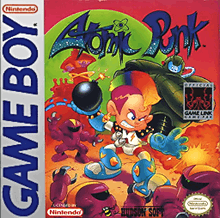Atomic Punk
Atomic Punk, released in Japan as Bomber Boy (ボンバーボーイ, Bonbā Bōi) and in Europe as Dynablaster, is a video game released for the Game Boy in 1990 by Hudson Soft and licensed by Nintendo, as part of the Bomberman series. It was the first game of the series to be released on the Game Boy.
| Atomic Punk | |
|---|---|
 North American cover art | |
| Developer(s) | Hudson Soft |
| Publisher(s) | NA/JP: Hudson Soft EU: Nintendo |
| Composer(s) | Jun Chikuma[1] Noriyuki Nakagami[1] Hirohiko Fukuda[1] |
| Series | Bomberman |
| Platform(s) | Game Boy |
| Release | |
| Genre(s) | Puzzle, action |
| Mode(s) | Single-player, multiplayer |
There are four modes of gameplay in Atomic Punk, including two single player modes and two multiplayer game modes.
Irem released the first Bomberman arcade game and its sequel Bomber Man World under the Atomic Punk name.[2]
Game A
Gameplay in the first mode, "Game A" (known as "Bomber Boy" in the Japanese version) is similar to other games in the series, with a few differences. Power-ups, known as panels, which are usually gained in each level and carried over from one to the next, can also be bought from a store by using GP, which is collected depending on how much time it takes to complete a level and how many blocks are destroyed. At the beginning of each round, the player decides which panels to use to complete the round. Another difference is that the linear gameplay of the original, with the player advancing levels after completing each one, was changed to implement a world map with nine locations.
The other map locations are those in which the game action takes place. Each area has a set number of rounds that have to be completed to finish the area. With the exception of Faria, these areas can be played in any order, but one area must be completed before moving onto another.
Reception
Mean Machines gave Atomic Punk a score of 81, praising the game as a "highly addictive" port of Bomberman, and added that the password system was a welcome addition.[3]
References
- Composer information for Atomic Punk at Portable Music History
- "Atomic Punk". The International Arcade Museum. Retrieved 1 Nov 2013.
- Rignall, Julian; Matt Regan (April 1991). "Bomber Boy Review". Mean Machines (7). Retrieved 2009-06-04.